Actionable Guide to SEO Keywords & Keyword Research

Keyword optimisation is SEO bread and butter. From honing your niche to undertaking keyword research, keywords will transform your online presence once you get them right.
Table of Contents
What are SEO keywords?
In SEO terms, keywords are the words and phrases that a user enters into a search engine when making their search query. The keywords that you choose to target should be an accurate representation of the content on your website. If you look at your website and break down all the content, including text, images and videos, into key topics and simple words and phrases, these are your keywords.
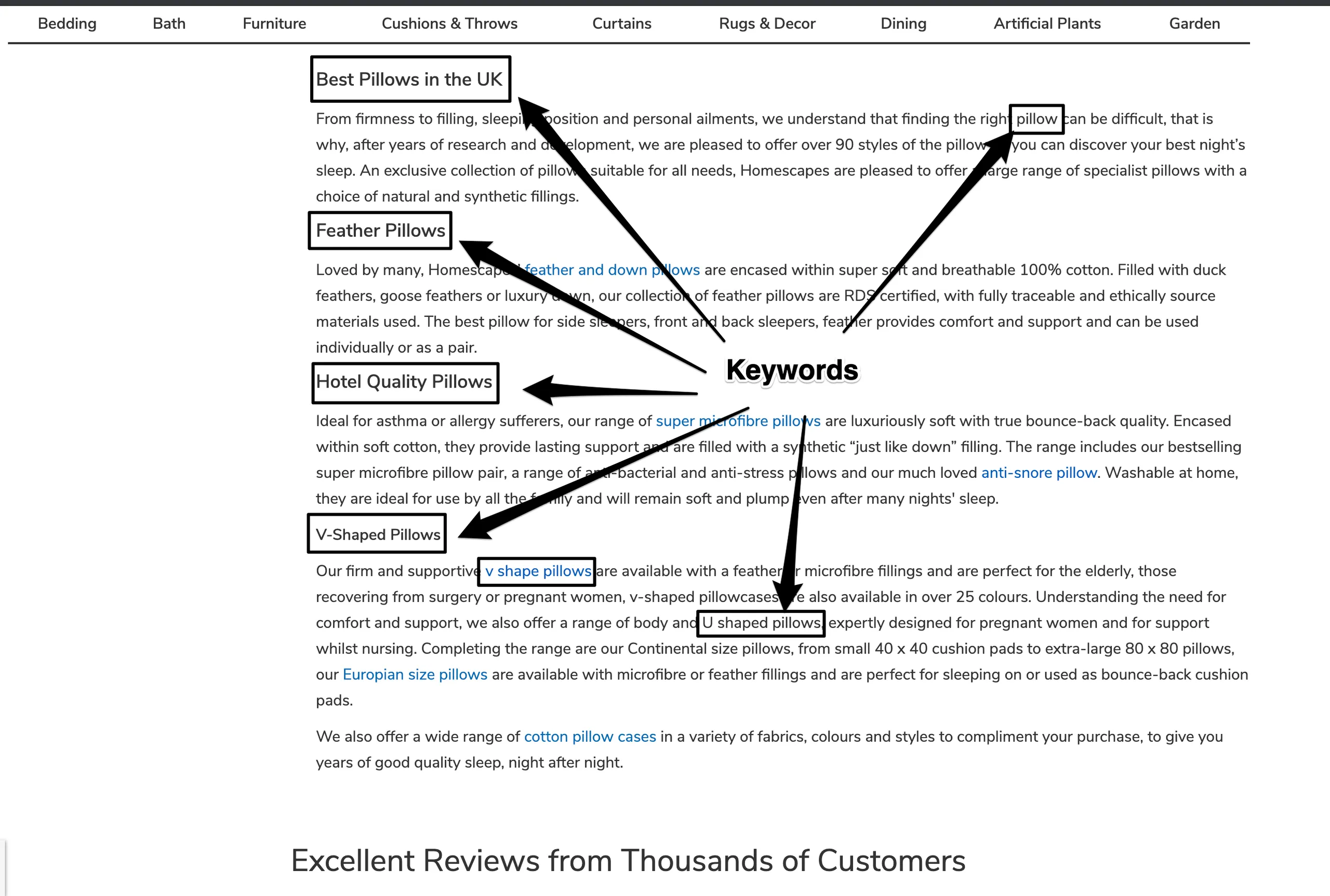
For your website to appear in search results for specific search terms, you need to ensure that your website offers high-quality content relevant to your chosen keywords. Getting to grips with keywords is especially important when creating a content strategy for your website. If you know what keywords you are hoping to target, you can ensure that you plan your online content around them.
Keywords are an essential part of any SEO strategy because they bridge the initial search query inputted into a search engine by a user and the content on your website. When improving your search rankings, the main goal is to increase the number of people who visit your website after you appear in search results. The keywords that you choose to target will help determine how well you rank and the amount and type of traffic you get to your website.
When deciding what keywords you want to target, you need to think carefully about both the content you provide and the search behaviour of your target audience. For your web pages to rank well and drive visitors to your website, you need to understand the exact needs of your target users. For instance, if you owned a high-end homeware company that specialises in glass wear, you may determine that a target keyword should be ‘luxury glasses’; however, this is a phrase that could also be used by users who are on the hunt for a new pair of designer reading glasses.
You must understand your target audience’s behaviour, search intent, and language your audience uses when selecting the keywords you want to target and rank for. The best way you can do this is by undertaking keyword research.
What is Keyword research & how do you do it?
Keyword research is the process of finding and analysing the search terms that users enter into a search engine to determine the most relevant keywords for you to target in your SEO strategy.
Keyword research gives you valuable insight into the topics that users are searching for, the language they’re using to make those searches and the intent behind the initial search query.
There are various ways you can find and analyse keywords to help form your overall content strategy.
Determine relevant topics in your niche - The first thing to do is think about the relevant topic areas that your website content falls into. Think about the key areas of your business and the topics that you would want to show up in search results for. Once you’ve determined the key topics your business focuses on, you can hone down each one with multiple keywords. For instance, if one of the topic areas your business focuses on is sofas, you can then determine relevant keywords and phrases within this topic such as ‘corner sofa’, ‘recliner sofa’ and ‘leather sofa’.
Always remember that the keywords you target need to be reflected on your website. It would be no use targeting’ leather sofa’ if you don’t actually sell any.
Look to Google for help - If you want to rank in Google’s results, then you may as well make use of the search engine when undertaking your keyword research. You can use various features, including autocomplete and related searches, to help you broaden your list of potential keywords.
To make use of Google’s autocomplete feature, you simply need to type in one of the keywords you’ve already determined into the search bar and see what search suggestions Google provides.
For instance, if you’ve determined that dining table is a keyword you want to target when you type it into the search bar, Google’s autocomplete feature will suggest key phrases relating to dining tables that users search for. You can then analyse which of these would be relevant for your website.
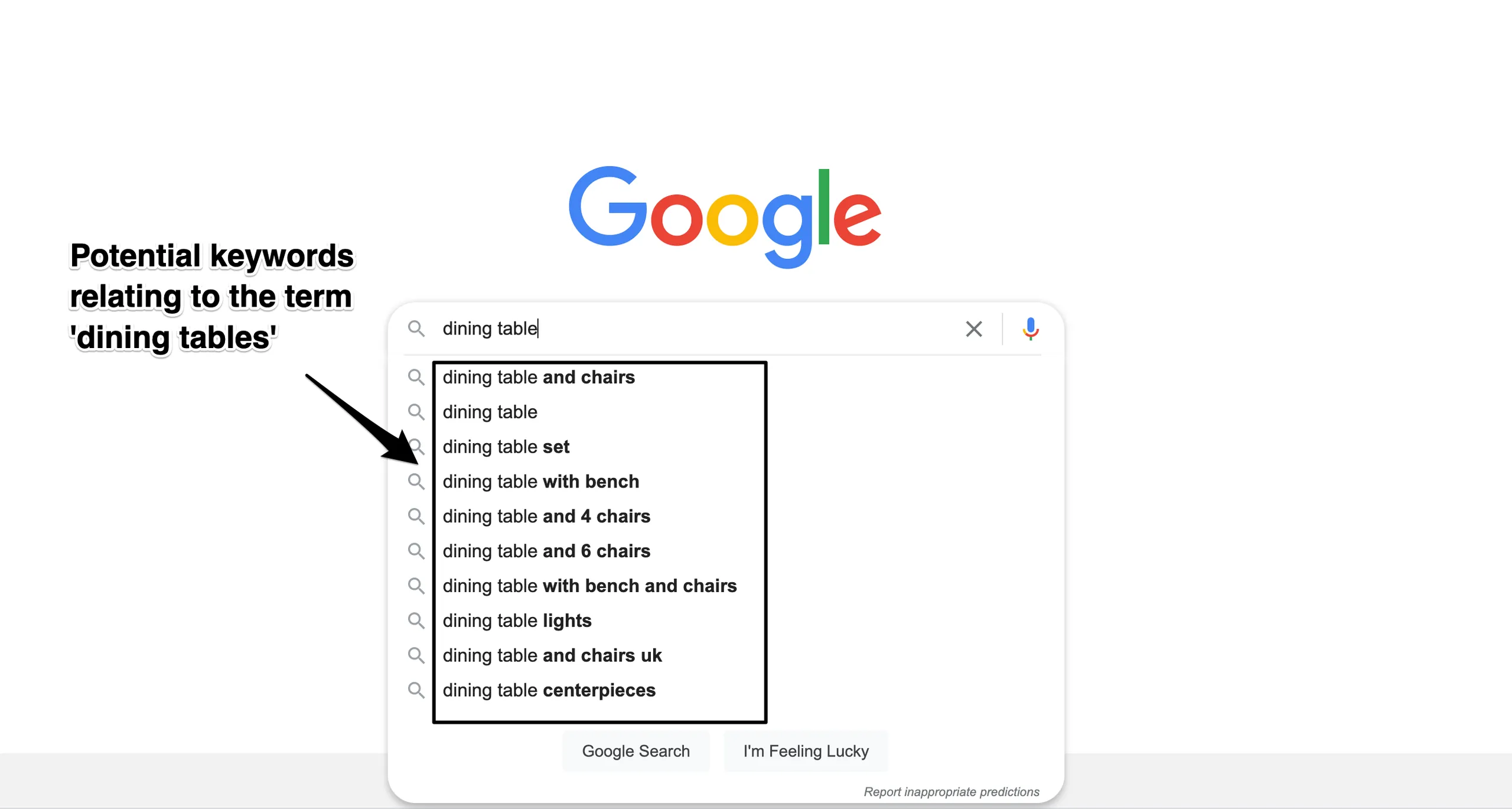
Google’s related searches feature works similarly by offering you similar search terms to your initial search at the bottom of your Google results page:
Use a specific keyword research tool - There are various tools available online that can undertake keyword research for you, offering up multiple options of keywords that you can look to target. Many keyword tools will analyse key metrics to provide you with the most relevant list of keywords. You can use the metrics they provide to handpick the best keywords from the list, ensuring you’re not wasting your time targeting a keyword with little chance of a conversion. Most keyword tools work by requiring you to input an initial keyword and then providing an extensive list of related words and phrases.
SEO tools such as Ahrefs and my personal favourite, SEMrush, can provide keyword lists based on both exact match and phrase match searches. Tools like these are a great way to uncover keywords and phrases that you may not have thought of in your previous research stages.
Here’s a screenshot of SEMRush’s excellent Keyword Magic Tool:
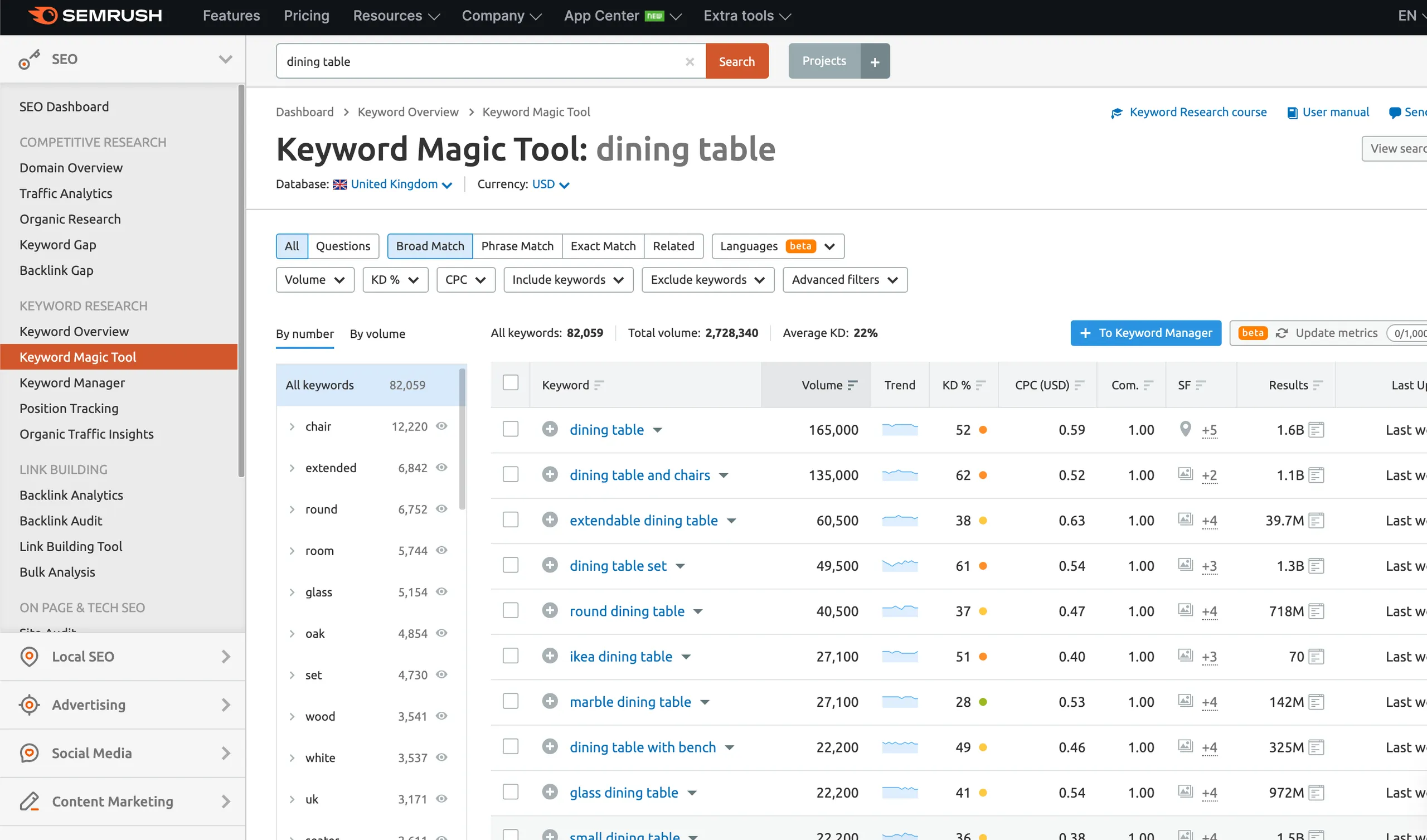
Grab a FREE SEMRush Trial
Undertake competitor analysis - No matter what your business niche, the likelihood is you’ll have undertaken competitor analysis for various areas of your business strategy. Deciding on your keywords is no different, and competitor analysis can be a great way of adding high-value keywords to your targeting list. Take a look at what key terms some of your competitors are ranking for. If they’re ranking for them, then you should be too.
Here’s a snapshot of the competitor intelligence reports that are available on SEMRush. You can look at your competitors top ranking keywords, traffic estimates and a whole host of other metrics:
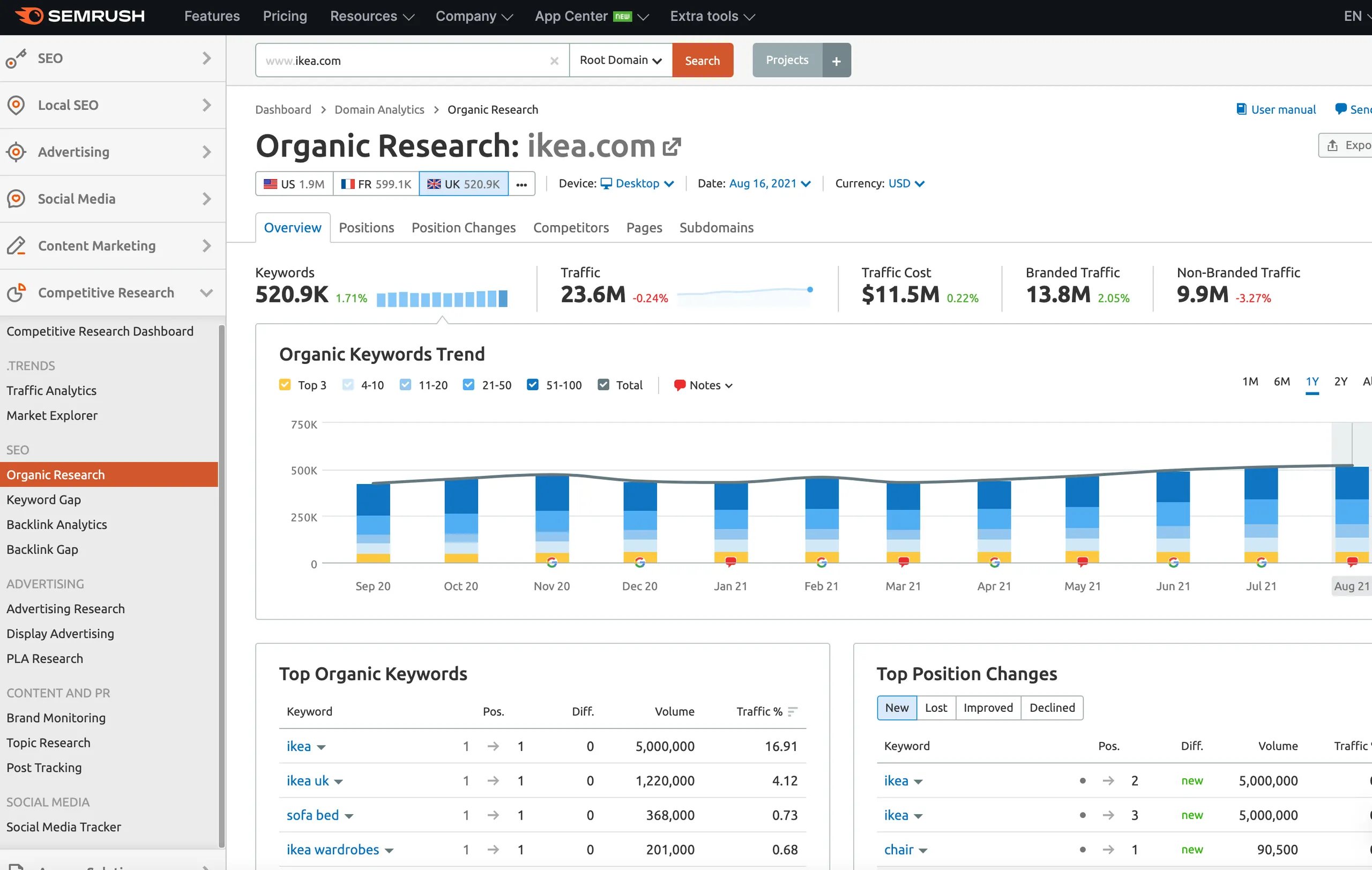
.... now THAT'S useful data. It's like having access to a competitors Google analytics!
Keyword metrics
Now you’ve got an idea of how you can research and find keywords to target; you need to understand precisely what you should be analysing to refine your list to the very best ones.
There are three key things you need to think about when analysing keywords. They are:
- Relevance
- Difficulty
- Volume
Ideally, you want to be targeting keywords that are the perfect balance of being relevant whilst having a high search volume and low difficulty level.
Relevance - Everything keeps coming back to relevance. Google will only rank content relevant to the search term, so when undertaking your keyword research, you must analyse whether or not the content on your website is relevant to the keyword.
With your researched keywords, you need to be focused on keywords that are genuinely relevant to your business:
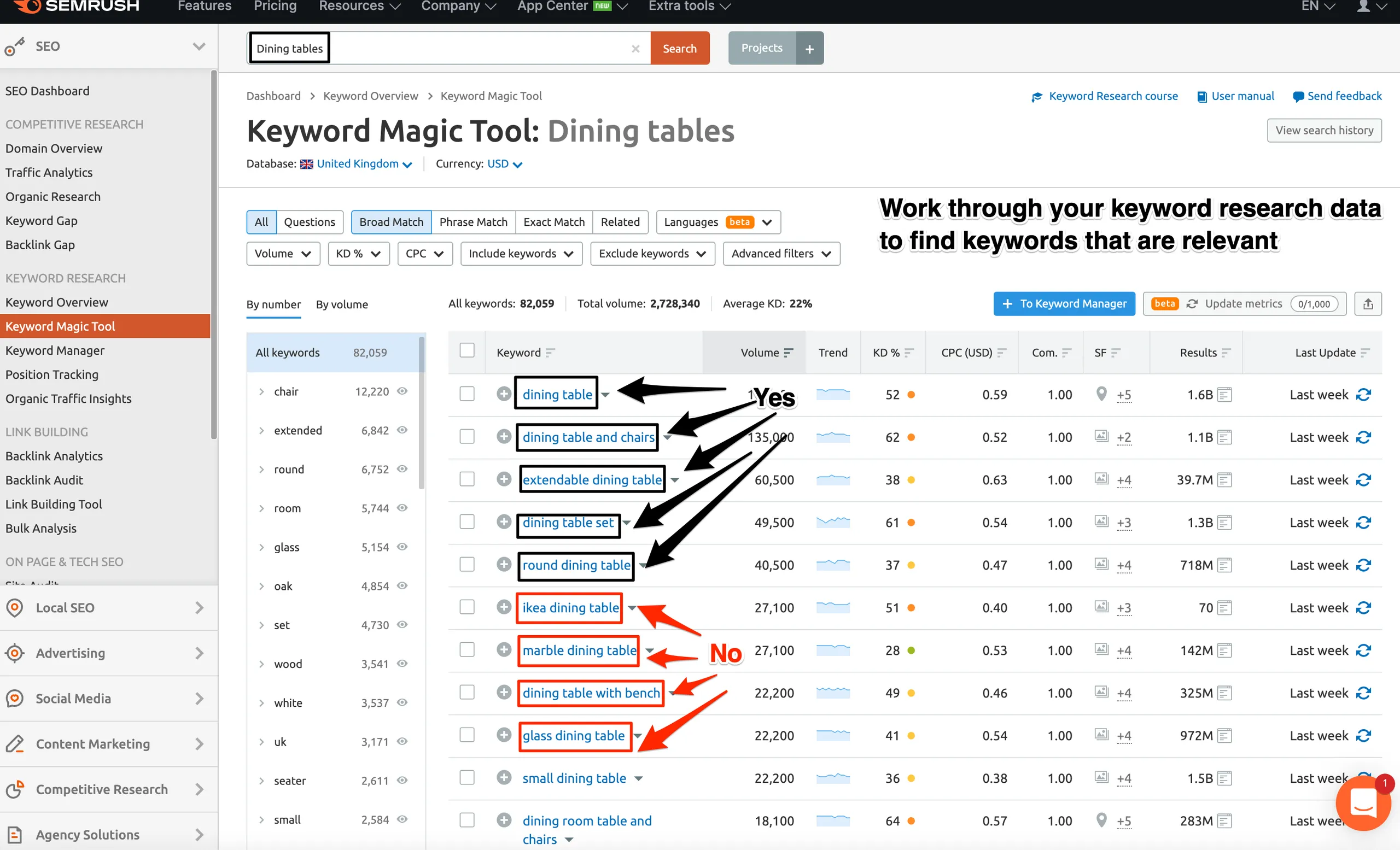
Your content needs to meet the user’s needs and provide them with the exact resource they were looking for when making the initial search query. Not only this, but you need to make sure that your content is the most appropriate option. Google isn’t going to rank you above a site that has higher-quality and more relevant content. To get the top spot, you’ve got to be the best.
Take a look at the SERPs for your chosen keywords and make a note of two things. Firstly the type of content Google is ranking for your search term. You may be an e-commerce business selling camping equipment and decide you want to rank for “best camping equipment” however, the results for this search term are all product reviews and expert guides. This tells you that Google sees this term as informational and will not rank a product page.
You can also use the SERPs to analyse the content that currently ranks in the top spot for your targeted search term. You need to determine if you can compete with them in terms of the quality and relevance of your content.
Volume - It’s all well and good ranking in first place for a keyword, but if nobody is searching for it, then that top position is worthless. You may as well not rank for it at all if it’s never being inputted into the search box.
Search volume is calculated by the number of times a keyword is searched per month, and you need to find a balance between targeting high-value keywords with a high search volume and being realistic.
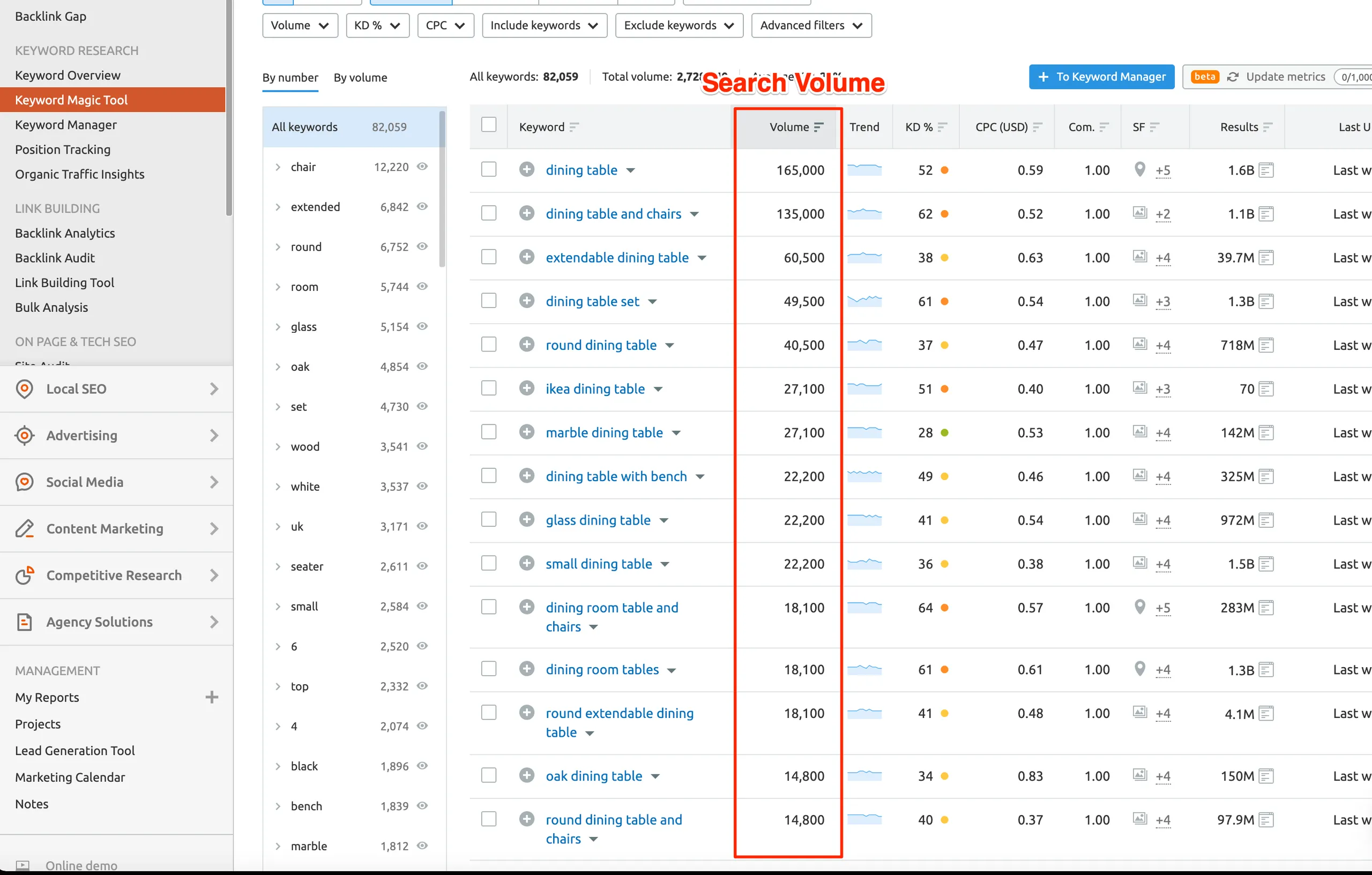
It’s unlikely that you will rank for the most popular search terms, especially if you’re a new website, so it may be more beneficial to opt for different variations. For example, the likelihood of you ranking for “Dining Tables” is pretty slim (in the short-term anyway); however, you would have a much better chance if you targeted “luxury wooden dining tables”.
Don’t put all of your efforts into ranking for keywords where the search volume is too high or too low. Keyword research has progressed substantially from when SEO experts first began undertaking it. Back then, finding the terms with the highest search volume and stuffing them into your content was the way. Now you need to evaluate what your chances are of being successful before you begin targeting.
Difficulty - Keyword difficulty refers to how hard (or easy) it is for you to rank well for a specific search term. It’s decided by analysing various factors, including the search volume of a term and the quality of the content on your page versus the quality of your competitors.
There are various tools you can use to discover the keyword difficulty of your chosen search terms. These tools will usually give the keyword a score; the higher the score, the harder it is to rank for that search term.
Here’s how it looks in SEMRush, they use a ‘traffic light’ system to show how hard (or indeed easy) it will be to rank for a specific term:

When determining how difficult it will be for you to rank for a keyword, there are certain aspects you need to consider.
- The quality of your competitor’s website and content. You’ll need to take a look at their on-site optimisation for the chosen keyword, the quality of the content they’re producing and their backlink profile.
- The authority of your website. Google only wants to rank websites with good authority, so ensuring you’ve built up a strong backlink profile of your own is essential.
- The quality of your content. Can you create content that targets your chosen keyword that is better than what your competitors are producing? If the answer is no, you can presume that it will be too difficult for you to rank well for your chosen keyword.
Google will consistently rank the content that it deems to be authoritative. Regardless of your chosen niche and keywords, you need to ensure that you’re doing everything you can to position yourself as an authoritative voice on the topic. Make sure you’re creating informative and valuable content, and keep promoting that content to prompt social media coverage and backlinks. It’s also worth looking at the type of website that currently ranks for that search term. If it’s one with high authority, such as Forbes or Wikipedia, then the chances of you knocking them off the top spot are almost non-existent.
Uncover your competitors keywords with the SEMRush Keyword tool FREE
What are Long-tail keywords?
Long-tail keywords are keywords that are longer and more specific than standard search queries. Long-tail keywords will often have a higher conversion rate as users that input them have a stronger search intent.
For example, a user searching for “trainers” is much less likely to convert than someone who searches for “Adidas Yeezy Boost Trainers”. The second option is more specific and suggests that the user knows exactly what results they are looking for.
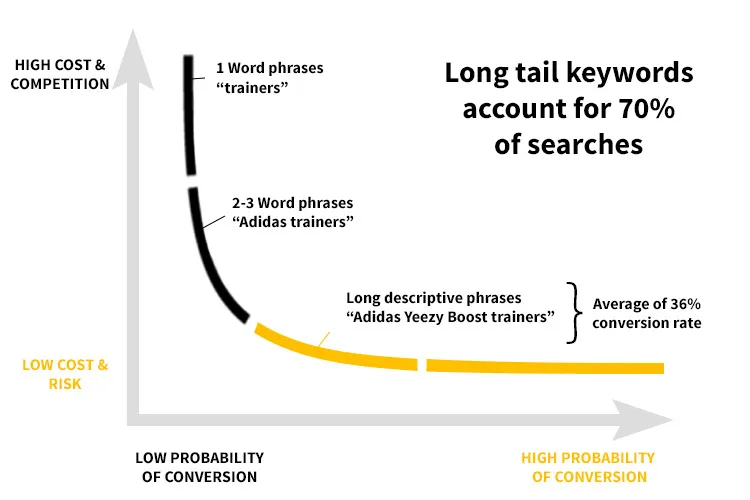
While long-tail keywords have more specific user intent, their search volume is usually much lower, so is their search difficulty.
Typically a long-tail keyword is used when a user is looking to take action. They aren’t looking for top-level content and instead have broken through the surface and want more in-depth information and resources.
You can approach long-tail keyword research in the same way you do standard keyword research. The key things to think about are the same, relevance, search volume and difficulty.
A great way to find long-tail keyword options to target is in Google’s related search feature. Here you will often find variations and longer phrases relating to your standard search terms.
How to implement keywords on your site (properly)
Once you’ve undertaken your keyword research and have a good understanding of the search terms that are most appropriate for you to target, you need to begin incorporating the keywords into your website. However, it’s no use just filling every page with as many keywords as possible to try and get Google’s attention; you still need to ensure you’re creating relevant and valuable content.

When adding your keywords to your content, you need to be careful. Keyword stuffing refers to the process of literally stuffing your website with keywords. Previously SEO experts would fill pages with keywords, repeating them in content, using backlink anchor text, hiding them in meta descriptions and even writing them in a font colour the same as the web page’s background colour to hide them. Unsurprisingly Google takes a negative view on keyword stuffing, and it’s classed as a black hat SEO tactic. It’s crucial, therefore, that you include your keywords naturally. Otherwise, you risk being penalised.
You should add your keywords to each page of your website where both Google’s bots and human users will naturally look. This is the best way to highlight that you have the exact content that they are looking for. The main places you should look to include your keywords include:
- Headers (also known as header tags) are often the first thing people see when they visit a web page, meaning they’re a key place to highlight the content’s main subject. Make sure you feature your keyword here; after all, if your keyword isn’t a relevant description of your content, then you shouldn’t be targeting it in the first place!
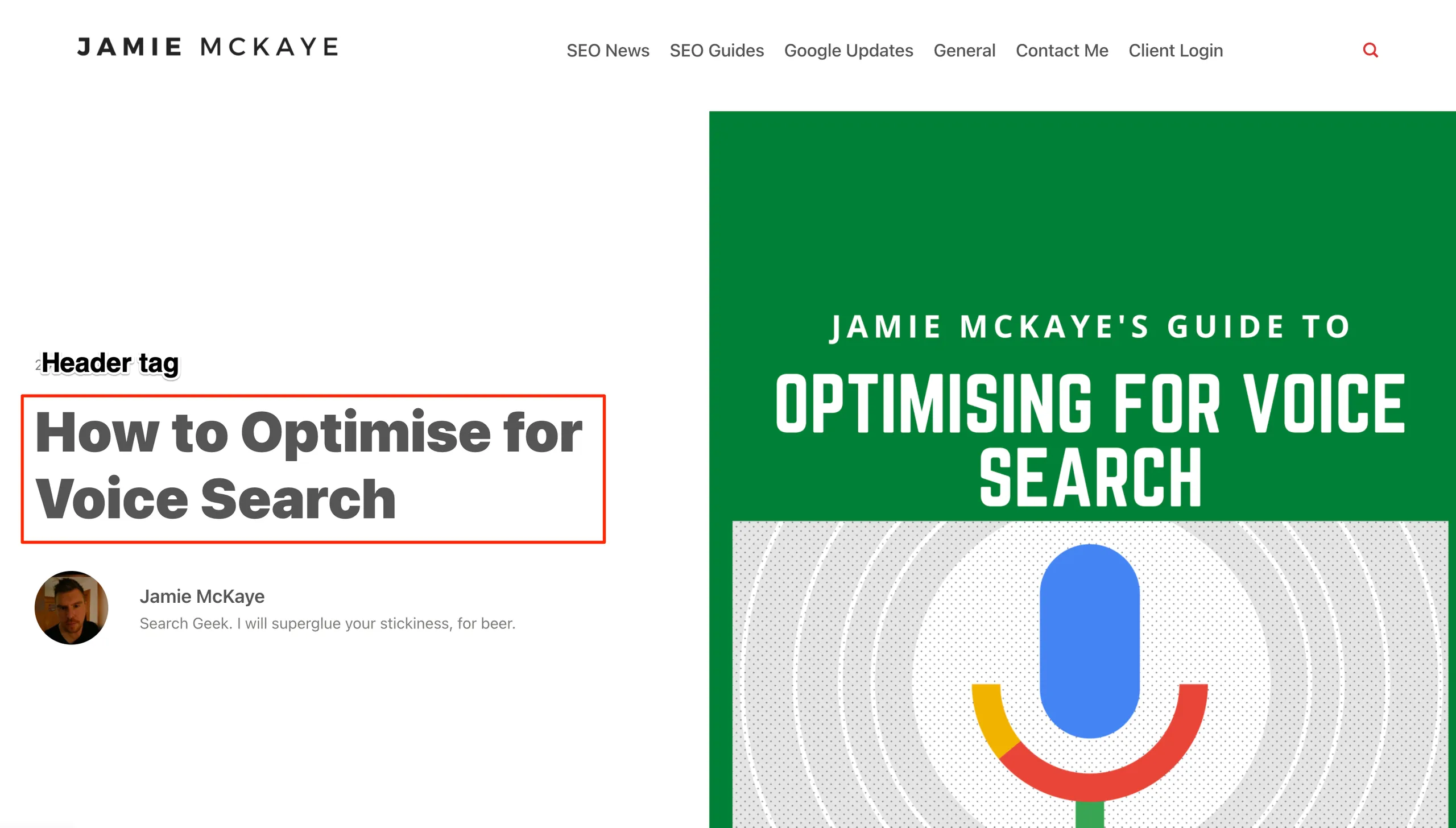
- Sub-headings - Sub-headings are a great place to tell Google’s bots what the content on your page is about. Not only do they break up text for a better user experience, they’re an ideal way to repeatedly feature your keywords without appearing spammy.
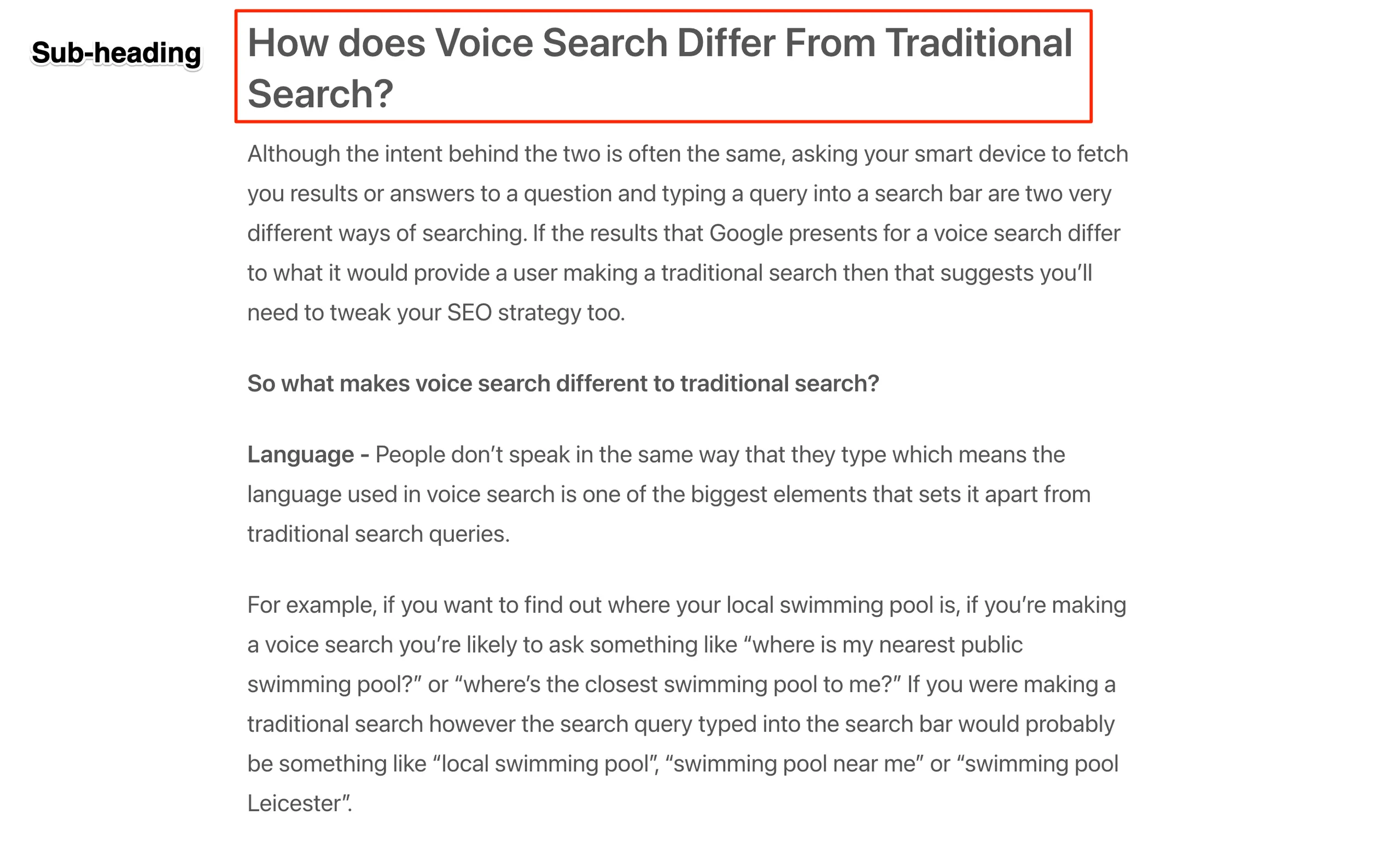
- Body text - The main body text of your web page should be well optimised to feature your keywords. Make sure you feature them as many times as you can whilst still keeping the content natural. You don’t want to make it obvious or get penalised for keyword stuffing but you can include different variations of your keyword in your body content to help towards improving your rankings.
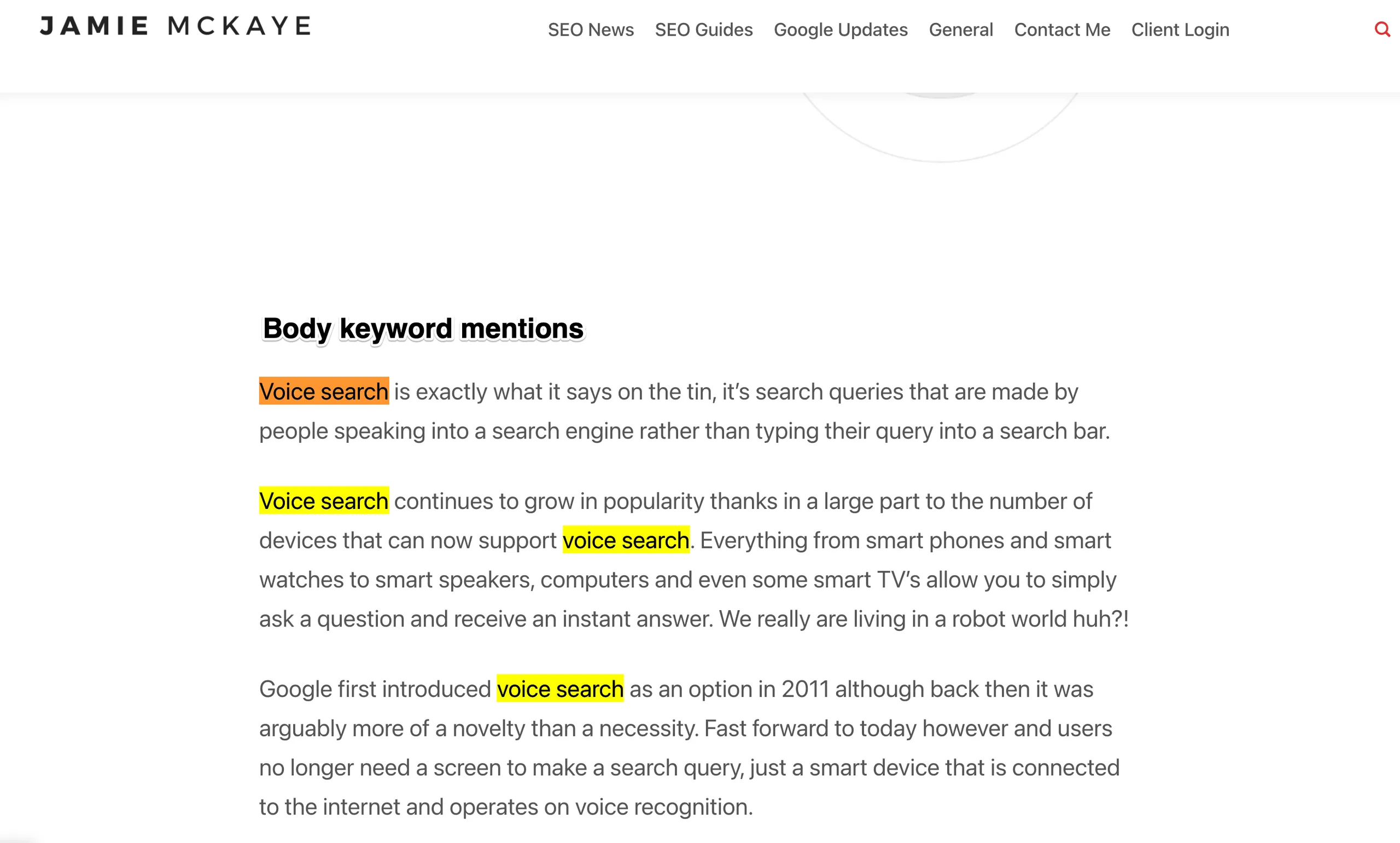
- Title tag and meta description - Your title tag and meta description is what appears in search results. Google is much more likely to rank a web page that features the search term in the title tag and meta description as this is a clear indicator that the content on the page matches the search term and intent. Title tags and meta descriptions are also a good way of signalling to users that they will find the content they’re looking for on your webpage; if they feature the keywords they’ve searched for, then they’re more likely to click on your listing.
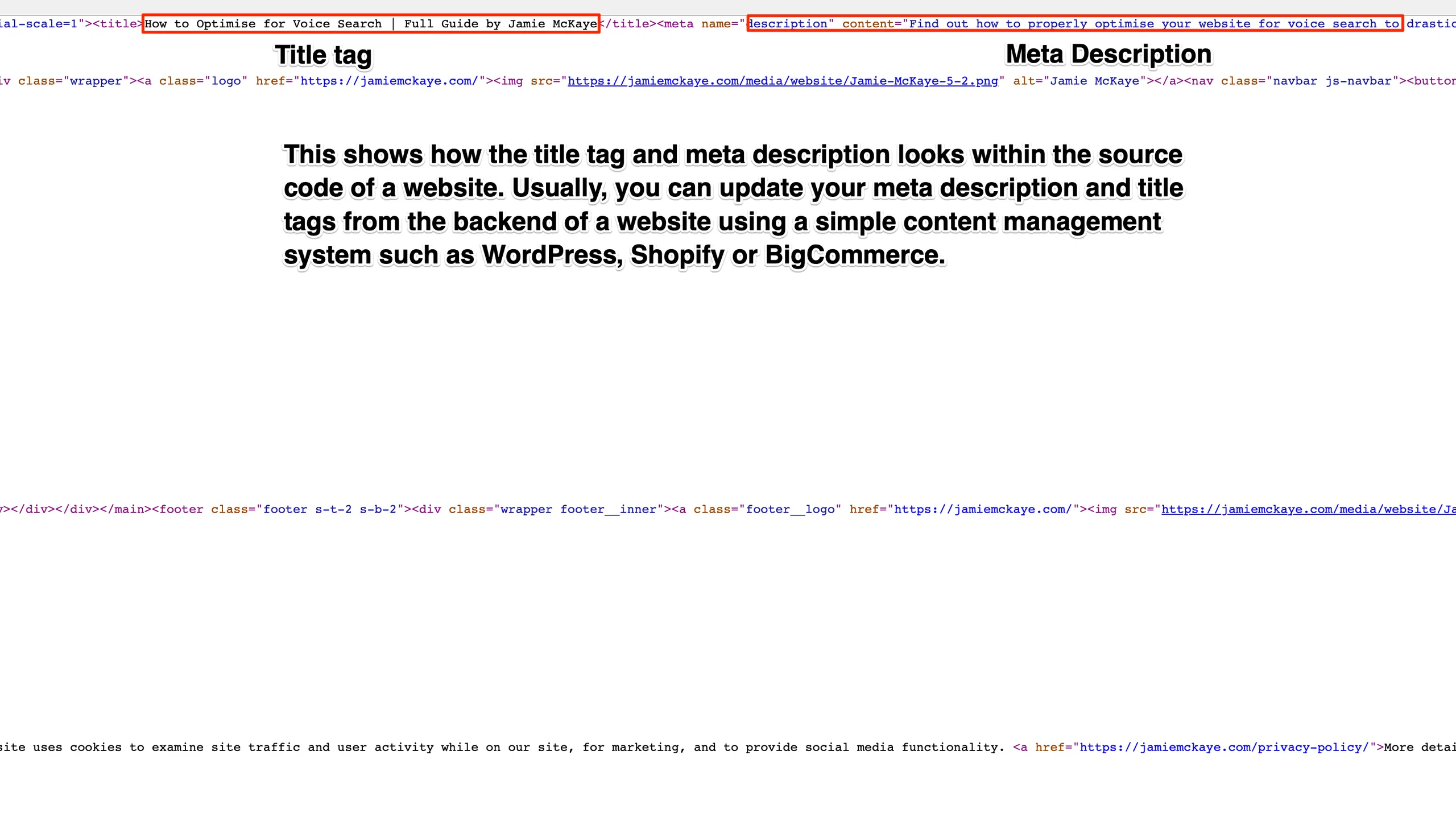
- Image alt text - Image alt text is a great way to speak directly to search engines. Alt text works as a description of the image and by featuring your keywords here you’re signaling to Google that the content you’ve created is relevant to your target keyword. Alt text allows search engines to read your image and understand whether or not it’s relevant to your content and search terms.
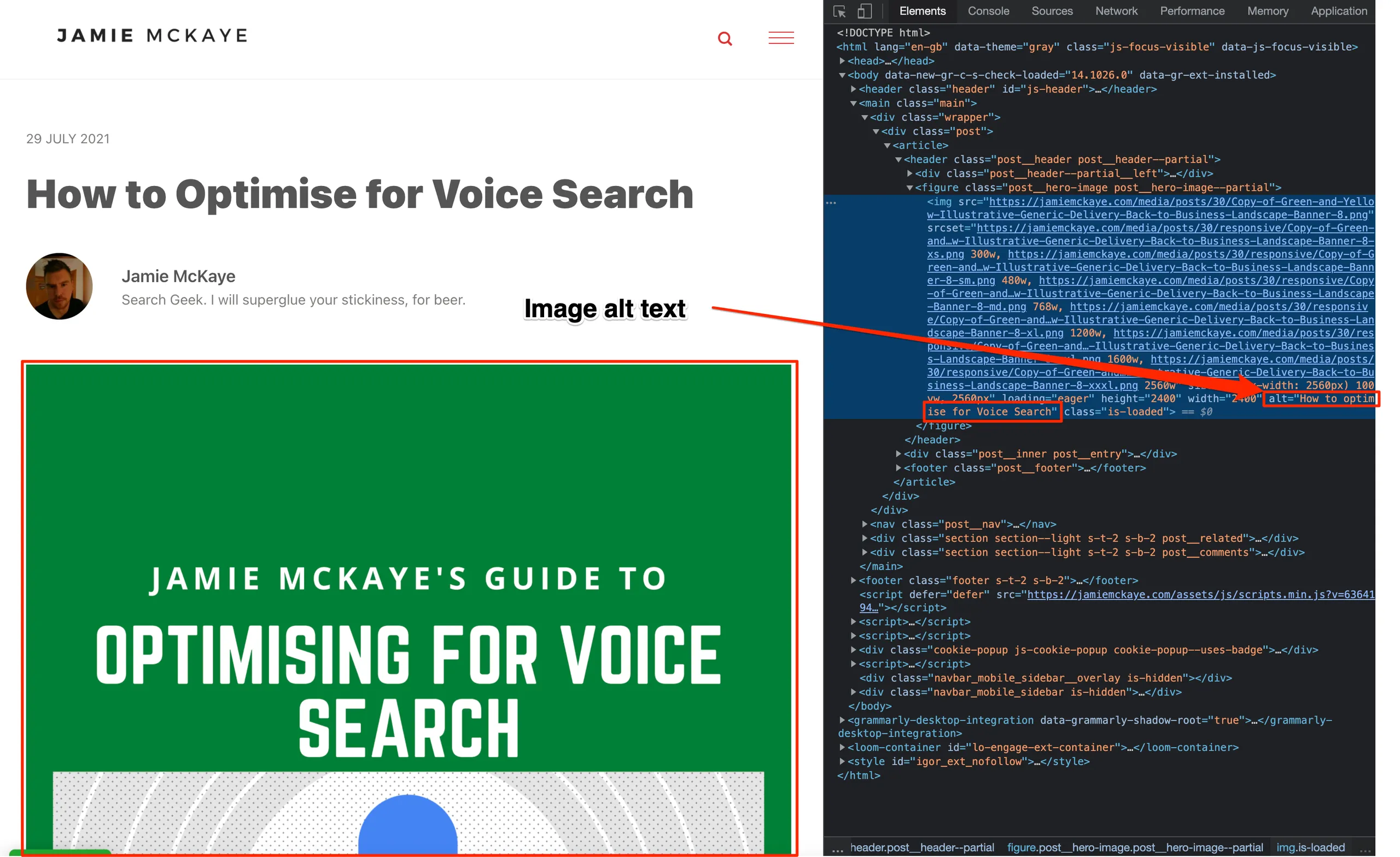
Adding your keywords to the above areas is a great way to ensure your website is well optimised for your chosen search terms without it appearing unnatural or spammy to both search engines and users. Just because you’ve added your keywords to your website doesn’t mean you’re going to automatically climb the rankings but failing to follow one of the most basic SEO principles can undoubtedly impact your overall SEO strategy.
My bottom line here is to write for people and not search engines. Have the keyword focus in the back of your mind and let your content flow naturally.





Comments